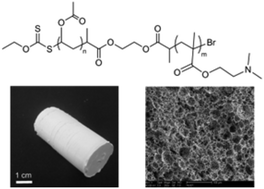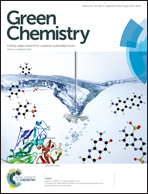Synthesis of a CO2-philic poly(vinyl acetate)-based cationic amphiphilic surfactant by RAFT/ATRP and its application in preparing monolithic materials†
Abstract
This study provides a new method to prepare CO2-philic amphiphilic surfactants by copolymerizing a less activated monomer (VAc) with an activated monomer (DMAEMA). Initially, the difunctional RAFT agent S-(1-methyl-4-hydroxyethyl acetate) O-ethyl dithiocarbonate, containing the xanthate group and 2-bromopropionyl group in its structure, was synthesized. By successive living radical polymerization, a series of new cationic surfactants poly(vinyl acetate)-block-poly(dimethylaminoethyl methacrylate) (PVAc-b-PDMAEMA) was obtained. PVAc-b-PDMAEMA cationic surfactants can emulsify CO2–H2O systems effectively to obtain high internal phase emulsion that remains stable up to 12 h. Further study indicates that the emulsifying ability of the surfactant is affected by the pH of solution, pressure, etc. After the high internal phase CO2-in-water (40% w/v, acrylamide solution) emulsion was polymerized, polyacrylamide-based highly porous emulsion-templated materials were obtained with tunable size and interconnected pores. These porous materials were then used as scaffolds to guide cellular growth.


 Please wait while we load your content...
Please wait while we load your content...